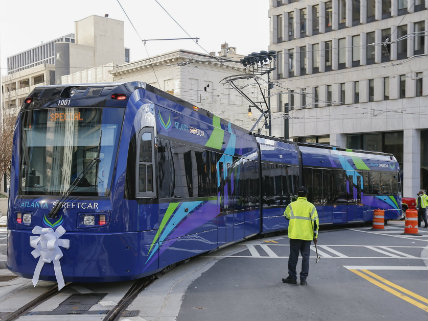Atlanta Plans To Blow More Money On Failed Streetcar Line
City leaders also want to build "glorified sidewalk" that will cost $4.8 billion.

Twenty-one months after it opened, the Atlanta Streetcar system is yet another expensive disaster in the long list of poorly planned urban transportation projects.
City officials are convinced, though, that the solution to the streetcar's problems is spending even more money to build a longer streetcar line—and a $4.8 billion sidewalk too.
The current streetcar line opened in December 2014. It runs over a 2.7-mile loop through the city's downtown and cost $98 million to build. Though ridership met the city's expectations for the first year, when it was free to hop aboard the streetcar, those numbers cratered in 2016 when the city started charging $1 per ride.
Over the first three months of the year, ridership was down by 62 percent. Even fewer people are actually paying: the mayor's office told the Atlanta Journal-Constitution that the streetcar provided 91,000 rides during the first three months of this year but the streetcar generated only $45,000 in revenue over the same period.
Even if the streetcar maintained the same ridership level (809,000 riders) that it had when it was free in 2015, a $1 per ride fare wouldn't come close to balancing out the streetcar's $5 million annual operating cost.
If all that weren't bad enough, the not-yet-two-years-old streetcar has been beset by management troubles, equipment failures and safety problems—including inaccurate reporting of safety issues and accidents. In May, the Georgia Department of Transportation threatened to shut down the streetcar unless the city's transit authority got things under control.
Now, Atlanta is moving forward with plans to build a 22-mile walking and biking trail completely surrounding downtown. Inspired by projects like High Line Park in New York City, Atlanta city planners want to use disused railway beds around the city to build one of the nation's largest pedestrian loops connecting 45 of the city's neighborhoods, the New York Times reported this week.
Of course the project wouldn't be complete unless the "glorified sidewalk"—as the Times called the Atlanta BeltLine project—was somehow connected to the failing streetcar system. The city's budget for the Beltline project calls for $3 million in spending this year to design a 1.5 mile extension of the existing streetcar line. If it gets built, the extension is likely to cost $62 million.
"Some people made a lot of money building the $200 million streetcar line. They no doubt are eager to make more building other lines," says Randal O'Toole, a transportation analyst for the libertarian Cato Institute. "But streetcars serve no viable transportation purpose except to spend money."
The city claims the streetcar has generated $1.5 billion in economic activity, but an investigation by the Journal-Constitution found that many of those claimed benefits come from building projects that were already happening before the streetcar was approved.
If the problems with the Atlanta Streetcar sound familiar, that's because they are. As Reason has noted repeatedly, light rail and streetcar systems are more expensive and less useful than other forms of mass transit.
The $200 million streetcar in Washington, D.C., runs for just 2.2 miles (twice as expensive and half a mile shorter than Atlanta's streetcar boondoggle). It was "was ill-planned, ill-thought-out, ill-engineered, ill-everything," as late former D.C. Mayor Marion Barry once put it.
Similar streetcar projects in Cincinnati, Dallas, Detroit and Honolulu are dealing with similar problems: construction cost overruns, small ridership and barely any evidence of economic benefits.
In Atlanta, it doesn't seem like the lesson has been learned—Atlanta's grand streetcar plan includes 50 miles of tracks at an estimated total cost of $1.5 billion.
Show Comments (55)